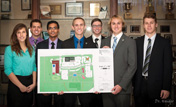Senior Capstone Partnership Assists Meridian Township Planning and Development
- Susan J. Masten
- Professor
- Department of Civil and Environmental Engineering
- College of Engineering

Student presenters Hayley Betker (environmental engineering), Kyle Jasina (transportation), Priyank Patel (hydrology), Evan Pomeroy (project manager), Charles Stcyr (transportation), Kyler Sheerin (pavement), and Duncan McLean (structure) at Engineering Design Day, December 5, 2014.
 Susan Masten regularly tracks and evaluates student outcomes of the EWB and other experiential learning encounters, and presents her findings at engineering education conferences. In August 2014 she presented a multiyear study at the International Conference of Engineering Education and Research in Hamilton, Ontario, about learning outcomes in a senior capstone design course that she teaches.
Susan Masten regularly tracks and evaluates student outcomes of the EWB and other experiential learning encounters, and presents her findings at engineering education conferences. In August 2014 she presented a multiyear study at the International Conference of Engineering Education and Research in Hamilton, Ontario, about learning outcomes in a senior capstone design course that she teaches.
The capstone partnership involves ongoing development of an area near campus in Meridian Township. Each new MSU student team is required to review township board minutes to understand the concerns and desires of the community for the site. This year the Township board requested that the students focus on a 30-acre site, ripe for mixed-use development. The site selected has high visibility in the community, but also some real challenges—wetlands, railroad easements, older (and somewhat obsolete) buildings, and multiple property owners. Redevelopment of this site would be transformative for the whole corridor.

"We benefit tremendously from the creative talents of the students in this collaboration. We need to attract young people to live, work, and play in Meridian in order to have a sustainable community. What better way to get ideas than involving young people in the actual design of the community? The students are helping us put our policy of enhancing diversity of our population, housing, and commerce into action."
Julie Brixie
Meridian Township Treasurer
Course learning objectives include mastery of teamwork, project management, professional practice, and effective communication. Students are assigned to teams, each led by a student project manager, that act as consulting firms. Each team is responsible for a subdisciplinary aspect of the project—environmental, water resources, geotechnical, transportation, and so on. Students in each of the subdisciplines are guided through the course by a faculty member in that subdiscipline. The course is organized to give all of the students an opportunity to interact across and learn about the multidimensional aspects of civil and environmental engineering.
What the students learn from the township are the real-world development standards and local ordinances that must be adhered to for site development. These standards are different in every community, but follow common state regulations.
Projects are assessed by professional engineers during Design Day (held at the end of each semester), when the students make a formal presentation to a panel of engineers who serve as the "client," along with any other interested parties (e.g., from the city or township, or county drain and road commissions) who care to attend.
All of these experiences have fortified Masten's belief in the power of engaged learning to meet course learning objectives, although she and her colleagues will continue to look for any keys that can be used to improve their courses. And, she says, the students and the professional evaluators all agree: "They both view it as a positive experience that prepares students well for the 'real world.'"
- Written by Linda Chapel Jackson, University Outreach and Engagement